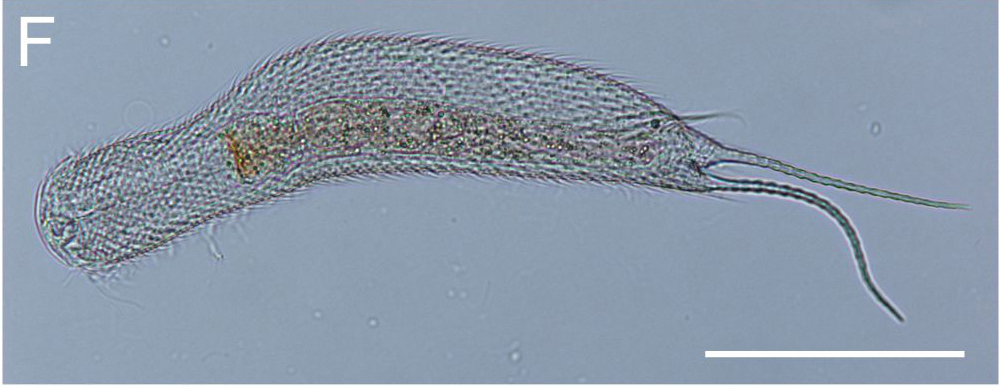|
Oncosphere
An oncosphere is the larval form of a tapeworm once it has been ingested by an intermediate host animal. The intermediate host must ingest the tapeworm's eggs either in food or water-- once this has happened, the eggs hatch and develop into oncospheres which will then burrow through the gut wall of the intermediate host in order to access the organs or tissues of that host where they will continue the next stage of their development as ''cysticerci'' or ''bladderworms''. The bladderworm is a cyst created by the oncosphere. In order to become an adult tapeworm, a cysticercus must then be consumed by its definitive host (in either raw or undercooked meat) and establish itself by anchoring in that host's digestive tract. From there, the worm will grow in length and eventually produce proglottids which will exit the intestinal tract with other waste material and then burst, releasing the worm's eggs and completing the cycle. See also * Hexacanth Eucestoda, commonly referred to a ... [...More Info...] [...Related Items...] OR: [Wikipedia] [Google] [Baidu] |
Bladderworm
Cestoda is a class of parasitic worms in the flatworm phylum (Platyhelminthes). Most of the species—and the best-known—are those in the subclass Eucestoda; they are ribbon-like worms as adults, known as tapeworms. Their bodies consist of many similar units known as proglottids—essentially packages of eggs which are regularly shed into the environment to infect other organisms. Species of the other subclass, Cestodaria, are mainly fish infecting parasites. All cestodes are parasitic; many have complex life histories, including a stage in a definitive (main) host in which the adults grow and reproduce, often for years, and one or two intermediate stages in which the larvae develop in other hosts. Typically the adults live in the digestive tracts of vertebrates, while the larvae often live in the bodies of other animals, either vertebrates or invertebrates. For example, ''Diphyllobothrium'' has at least two intermediate hosts, a crustacean and then one or more freshwater fis ... [...More Info...] [...Related Items...] OR: [Wikipedia] [Google] [Baidu] |
Proglottid
Cestoda is a class of parasitic worms in the flatworm phylum (Platyhelminthes). Most of the species—and the best-known—are those in the subclass Eucestoda; they are ribbon-like worms as adults, known as tapeworms. Their bodies consist of many similar units known as proglottids—essentially packages of eggs which are regularly shed into the environment to infect other organisms. Species of the other subclass, Cestodaria, are mainly fish infecting parasites. All cestodes are parasitic; many have complex life histories, including a stage in a definitive (main) host in which the adults grow and reproduce, often for years, and one or two intermediate stages in which the larvae develop in other hosts. Typically the adults live in the digestive tracts of vertebrates, while the larvae often live in the bodies of other animals, either vertebrates or invertebrates. For example, '' Diphyllobothrium'' has at least two intermediate hosts, a crustacean and then one or more freshwater fi ... [...More Info...] [...Related Items...] OR: [Wikipedia] [Google] [Baidu] |
Cestoda
Cestoda is a class of parasitic worms in the flatworm phylum (Platyhelminthes). Most of the species—and the best-known—are those in the subclass Eucestoda; they are ribbon-like worms as adults, known as tapeworms. Their bodies consist of many similar units known as proglottids—essentially packages of eggs which are regularly shed into the environment to infect other organisms. Species of the other subclass, Cestodaria, are mainly fish infecting parasites. All cestodes are parasitic; many have complex life histories, including a stage in a definitive (main) host in which the adults grow and reproduce, often for years, and one or two intermediate stages in which the larvae develop in other hosts. Typically the adults live in the digestive tracts of vertebrates, while the larvae often live in the bodies of other animals, either vertebrates or invertebrates. For example, '' Diphyllobothrium'' has at least two intermediate hosts, a crustacean and then one or more freshwater fi ... [...More Info...] [...Related Items...] OR: [Wikipedia] [Google] [Baidu] |
Tapeworm
Eucestoda, commonly referred to as tapeworms, is the larger of the two subclasses of flatworms in the class Cestoda (the other subclass is Cestodaria). Larvae have six posterior hooks on the scolex (head), in contrast to the ten-hooked Cestodaria. All tapeworms are endoparasites of vertebrates, living in the digestive tract or related ducts. Examples are the pork tapeworm (''Taenia solium'') with a human definitive host, and pigs as the secondary host, and ''Moniezia expansa'', the definitive hosts of which are ruminants. Body structure Adult Eucestoda have a white-opaque dorso-ventrally flattened appearance, and are elongated, ranging in length from a few millimeters to 25 meters. Almost all members, except members of the orders Caryophyllidea and Spathebothriidea, are polyzoic with repeated sets of reproductive organs down the body length, and almost all members, except members of the order Dioecocestidae, are protandral hermaphrodites. Most except caryophyllideans consist ... [...More Info...] [...Related Items...] OR: [Wikipedia] [Google] [Baidu] |
Hexacanth
Eucestoda, commonly referred to as tapeworms, is the larger of the two subclasses of flatworms in the class Cestoda (the other subclass is Cestodaria). Larvae have six posterior hooks on the scolex (head), in contrast to the ten-hooked Cestodaria. All tapeworms are endoparasites of vertebrates, living in the digestive tract or related ducts. Examples are the pork tapeworm (''Taenia solium'') with a human definitive host, and pigs as the secondary host, and ''Moniezia expansa'', the definitive hosts of which are ruminants. Body structure Adult Eucestoda have a white-opaque dorso-ventrally flattened appearance, and are elongated, ranging in length from a few millimeters to 25 meters. Almost all members, except members of the orders Caryophyllidea and Spathebothriidea, are polyzoic with repeated sets of reproductive organs down the body length, and almost all members, except members of the order Dioecocestidae, are protandral hermaphrodites. Most except caryophyllideans consist ... [...More Info...] [...Related Items...] OR: [Wikipedia] [Google] [Baidu] |
Vuitton Et Al - International Consensus On Terminology - Parasite200043-fig2ab
Louis Vuitton Malletier, commonly known as Louis Vuitton (, ), is a French high-end Luxury goods, luxury fashion house and company founded in 1854 by Louis Vuitton (designer), Louis Vuitton. The label's LV monogram appears on most of its products, ranging from luxury bags and leather goods to ready-to-wear, shoes, watches, jewelry, accessories, sunglasses and books. Louis Vuitton is one of the world's leading international fashion houses. It sells its products through standalone boutiques, lease departments in high-end department stores, departmental stores, and through the e-commerce section of its website. For six consecutive years (2006–2012), Louis Vuitton was named the world's most valuable luxury brand. Its 2012 valuation was US$25.9 billion. In 2013, the valuation of the brand was US$28.4 billion with revenue of US$9.4 billion. The company operates in 50 countries with more than 460 stores worldwide. History Founding to World War II The Louis Vuitton label was founde ... [...More Info...] [...Related Items...] OR: [Wikipedia] [Google] [Baidu] |
Intermediate Host
In biology and medicine, a host is a larger organism that harbours a smaller organism; whether a parasitic, a mutualistic, or a commensalist ''guest'' (symbiont). The guest is typically provided with nourishment and shelter. Examples include animals playing host to parasitic worms (e.g. nematodes), cells harbouring pathogenic (disease-causing) viruses, a bean plant hosting mutualistic (helpful) nitrogen-fixing bacteria. More specifically in botany, a host plant supplies food resources to micropredators, which have an evolutionarily stable relationship with their hosts similar to ectoparasitism. The host range is the collection of hosts that an organism can use as a partner. Symbiosis Symbiosis spans a wide variety of possible relationships between organisms, differing in their permanence and their effects on the two parties. If one of the partners in an association is much larger than the other, it is generally known as the host. In parasitism, the parasite benefits at the ... [...More Info...] [...Related Items...] OR: [Wikipedia] [Google] [Baidu] |
Definitive Host
In biology and medicine, a host is a larger organism that harbours a smaller organism; whether a parasitic, a mutualistic, or a commensalist ''guest'' (symbiont). The guest is typically provided with nourishment and shelter. Examples include animals playing host to parasitic worms (e.g. nematodes), cells harbouring pathogenic (disease-causing) viruses, a bean plant hosting mutualistic (helpful) nitrogen-fixing bacteria. More specifically in botany, a host plant supplies food resources to micropredators, which have an evolutionarily stable relationship with their hosts similar to ectoparasitism. The host range is the collection of hosts that an organism can use as a partner. Symbiosis Symbiosis spans a wide variety of possible relationships between organisms, differing in their permanence and their effects on the two parties. If one of the partners in an association is much larger than the other, it is generally known as the host. In parasitism, the parasite benefits at the ... [...More Info...] [...Related Items...] OR: [Wikipedia] [Google] [Baidu] |






.jpg)